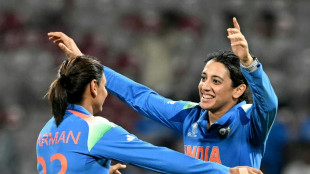
-
 Pollock shines as England eventually overpower Australia
Pollock shines as England eventually overpower Australia
-
Villarreal crush Rayo to move second, Atletico beat Sevilla

-
 Sinner crushes Zverev to reach Paris Masters final, brink of No. 1
Sinner crushes Zverev to reach Paris Masters final, brink of No. 1
-
Pollock shines as England beat Australia in Autumn opener

-
 Ukraine sends special forces to embattled eastern city
Ukraine sends special forces to embattled eastern city
-
Arsenal cruise against Burnley as Man Utd held

-
 Pollock shines as England beat Australia 25-7 in Autumn Nations Series
Pollock shines as England beat Australia 25-7 in Autumn Nations Series
-
Gyokeres on target as leaders Arsenal beat Burnley

-
 Woman charged over Louvre heist tears up in court
Woman charged over Louvre heist tears up in court
-
Diomande dazzles as Leipzig go two points behind Bayern

-
 Auger-Aliassime downs Bublik to reach Paris Masters final
Auger-Aliassime downs Bublik to reach Paris Masters final
-
Villarreal crush Rayo to move second in La Liga

-
 Female suspect, 38, charged in Louvre heist: AFP
Female suspect, 38, charged in Louvre heist: AFP
-
US not sending any high-level officials to COP30

-
 India captain Kaur sees World Cup final as possible turning point
India captain Kaur sees World Cup final as possible turning point
-
'Not out of the woods': What now for Britain's ex-prince Andrew?

-
 Tens of thousands of Serbians mark first anniversary of deadly train station collapse
Tens of thousands of Serbians mark first anniversary of deadly train station collapse
-
Tanzania president wins 98% in election as opposition says hundreds killed

-
 Vieira 'no longer' manager of troubled Genoa: club
Vieira 'no longer' manager of troubled Genoa: club
-
Tanzania president wins 98% of votes after violence-marred polls

-
 South Korea hosts Xi as Chinese leader rekindles fraught ties
South Korea hosts Xi as Chinese leader rekindles fraught ties
-
England's batting exposed as New Zealand seal ODI series sweep

-
 Funk legend turned painter George Clinton opens show in Paris
Funk legend turned painter George Clinton opens show in Paris
-
Traditional mass wedding held in Nigeria to ensure prosperity

-
 Canada PM says Xi talks 'turning point', apologises to Trump
Canada PM says Xi talks 'turning point', apologises to Trump
-
Iranian tech prodigies battle it out with robots

-
 Maldives begins 'generational ban' on smoking
Maldives begins 'generational ban' on smoking
-
Explorers seek ancient Antarctica ice in climate change study

-
 India's Iyer discharged from hospital after lacerated spleen
India's Iyer discharged from hospital after lacerated spleen
-
Serbia marks first anniversary of deadly train station collapse

-
 Latin America weathered Trump tariffs better than feared: regional bank chief
Latin America weathered Trump tariffs better than feared: regional bank chief
-
Bangladesh dockers strike over foreign takeover of key port

-
 Tanzania president wins election landslide after deadly protests
Tanzania president wins election landslide after deadly protests
-
Sixers suffer first loss, Bulls stay perfect as NBA Cup opens

-
 Dodgers, Blue Jays gear up for winner-take-all World Series game seven
Dodgers, Blue Jays gear up for winner-take-all World Series game seven
-
Taiwan's new opposition leader against defence spending hike

-
 China to exempt some Nexperia chips from export ban
China to exempt some Nexperia chips from export ban
-
Dodgers hold off Blue Jays 3-1 to force World Series game seven

-
 Crowns, beauty, fried chicken: Korean culture meets diplomacy at APEC
Crowns, beauty, fried chicken: Korean culture meets diplomacy at APEC
-
Panama wins canal expansion arbitration against Spanish company

-
 Myanmar fireworks festival goers shun politics for tradition
Myanmar fireworks festival goers shun politics for tradition
-
China to exempt some Nexperia orders from export ban

-
 Sixers suffer first loss as NBA Cup begins
Sixers suffer first loss as NBA Cup begins
-
China's Xi to meet South Korean leader, capping APEC summit

-
 Japan's Chiba leads after Skate Canada short program
Japan's Chiba leads after Skate Canada short program
-
Finland's crackdown on undocumented migrants sparks fear

-
 Climbers test limits at Yosemite, short-staffed by US shutdown
Climbers test limits at Yosemite, short-staffed by US shutdown
-
Gstaad gives O'Brien record 21st Breeders' Cup win

-
 After the tears, anger on Rio's blood-stained streets
After the tears, anger on Rio's blood-stained streets
-
LiberNovo Omni Launches as Black Friday Countdown Begins


Nuking a huge asteroid could save Earth, lab experiment suggests
Humanity could use a nuclear bomb to deflect a massive, life-threatening asteroid hurtling towards Earth in the future, according to scientists who tested the theory in the labaratory by blasting X-rays at a marble-sized "mock asteroid".
The biggest real-life test of our planetary defences was carried out in 2022, when NASA's fridge-sized DART spacecraft smashed into a 160-metre (525-feet) wide asteroid, successfully knocking it well off course.
But for bigger asteroids, merely crashing spaceships into them will probably not do the trick.
When the roughly 10-kilometre wide Chicxulub asteroid struck the Yucatan peninsula around 66 million years ago, it is believed to have plunged Earth into darkness, sent kilometres-high tsunamis rippling around the globe and killed three quarters of all life -- including wiping out the dinosaurs.
We humans are hoping to avoid a similar fate.
There is no current threat looming, but scientists have been working on how to stave off any big asteroids that could come our way in the future.
A leading theory has been to be blow them up with a nuclear bomb -- a last-ditch plan famously depicted in the 1998 sci-fi action movie "Armageddon".
In the movie, Bruce Willis and a plucky team of drillers save Earth from an asteroid 1,000 kilometres wide -- roughly the size of Texas.
For a proof-of-concept study published in the journal Nature Physics this week, a team of US scientists worked on a much smaller scale, taking aim at a mock asteroid just 12 millimetres (half an inch) wide.
To test whether the theory would work, they used what was billed as the world's largest X-ray machine at Sandia National Laboratories in Albuquerque, New Mexico.
The machine is capable of generating "the brightest flash of X-rays in the world using 80 trillion watts of electricity", Sandia's Nathan Moore, the lead study author, told AFP.
Much of the energy created by a nuclear explosion is in the form of X-rays. Since there is no air in space, there would be no shockwave or fireball.
But the X-rays still pack a powerful punch.
- Turned into a 'rocket engine' -
For the lab experiment, the X-rays easily vaporised the surface of the mock asteroid.
The vaporising material then propelled the mock asteroid in the opposite direction, so that it effectively "turned into a rocket engine," Moore said.
It reached speeds of 250 kilometres an hour, "about as fast as a high-speed train," he added.
The test marked the first time that predictions about how X-rays would affect an asteroid had been confirmed, Moore said.
"It really proves this concept could work."
The scientists used modelling to scale up their experiment, estimating that X-rays from a nuclear blast could deflect an asteroid up to four kilometres wide -- if given enough advanced notice.
The biggest asteroids are the easiest to detect ahead of time, so "this approach could be quite viable" even for asteroids the size of the dinosaur-killing Chicxulub, Moore said.
The experiment was based on using a one-megaton nuclear weapon. The largest ever detonated was the 50-megaton Soviet Tsar Bomba.
If there was to be a planet-saving mission in the future, the nuclear bomb would need to be placed within a few kilometres of the asteroid -- and millions of kilometres away from Earth, Moore said.
- Asteroids come in many flavours -
Testing out the theory using a real nuke would be dangerous, hugely expensive -- and banned by international treaties.
But there is still plenty to be discovered before such a high-risk test.
The largest uncertainty right now is that asteroids can "come in many flavours", Moore said.
"We have to be prepared for every scenario."
For example, the asteroid hit by DART, Dimorphos, turned out to be a loosely held-together pile of rubble.
The European Space Agency's Hera mission is scheduled to launch next month on a mission to find out more about its composition -- and the finer details about how DART sent it packing.
Mary Burkey, a staff scientist at California's Lawrence Livermore National Laboratory that was not involved in the new study, has run computer simulations about using nukes on asteroids.
She praised the study, saying that "being able to match my calculations to real-life data increases the credibility of my results."
Her simulations have also demonstrated that such a mission "would be a very effective means to defend planet Earth", Burkey told AFP.
"However, in order for it to work, there must be enough time after a mission for the extra push of velocity to move the asteroid's trajectory off Earth."
F.Bennett--AMWN

